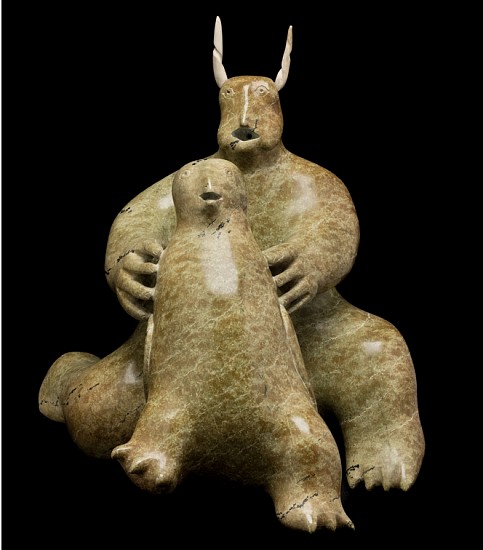Nuyaliaq Qimirpik



Nuyaliaq Qimirpik, Horned Spirit and Owl, 1968-70
17 x 15 1/2 x 17 in.
For a brief period of perhaps no more than three or four years (c. 1968-1971), a small group of carvers in Kimmirut, led by Nuyaliaq, created a remarkable and delightful group of spirit carvings, apparently at the request of a local schoolteacher named Tony Whitbourne who was buying carvings for the government for a short time. This spiritual flowering of art reminds us of a similar occurrence in nearby Cape Dorset in the early 1960s, but unfortunately in the case of Kimmirut art the florescence was not sustained – a sad loss for Inuit art. Nuyaliaq's Horned Spirit and Owl is a splendid example of the style. On the one hand the sculpture is poetic and haunting, on the other, it is incredibly charming. The horned figure might in fact be a transforming shaman; its overall posture and very human hands contrast with the bear-like body and bird-like head. The large figure holds its young owl companion almost as if presenting it as an offering or readying it for a spiritual journey. Both mouth and beak are agape in awe. Today Nuyaliaq Qimirpik is best known as an accomplished carver of muskoxen. It is our pleasure to offer this sculpture by the artist as a work of profound spirituality and captivating beauty. References: For other fine spirit sculptures by this artist see Bernadette Driscoll, Baffin Island, (Winnipeg Art Gallery, 1983) cat. 57, or Darlene Wight, The Swinton Collection of Inuit Art, (Winnipeg Art Gallery, 1987) cat. 134; Maria von Finckenstein ed., Celebrating Inuit Art 1948-1970, (Canadian Museum of Civilization, 1999) p. 129. A fine Spirit with Young from c. 1968 is illustrated in George Swinton, Sculpture of the Inuit, (McClelland & Stewart, 1972/92), fig. 517, p. 195. Three of Nuyaliaq's spirit sculptures are illustrated in Maria von Finckenstein, “Four Works from Kimmirut†in Inuit Art Quarterly, (Vol. 14, No. 1, Spring 1999:40-41).
03571-1


